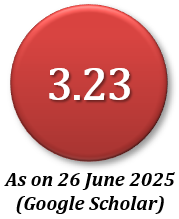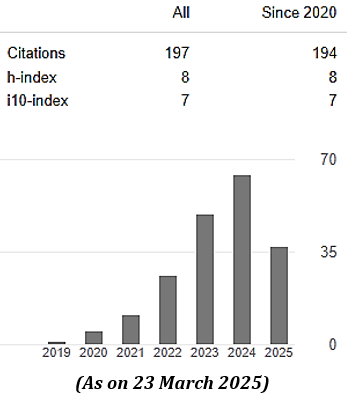Land-Use and Land-Cover Change in Dhaka Eastern Region and Its Impact on Surface Run-off
Abstract
The aim of this study is to identify the impending urbanization-led land-use and land-cover (LULC) change of Dhaka Eastern Region (DER) and assessing its impact on surface runoff. Remotely sensed image data and proposed land-use plans for DER is analyzed and mapped in this study to detect the changes of LULC. A faster pace of land transformation was observed during 2016-17 from unpaved to the paved surface. Four post-developed LULC scenarios were predicted from the classified Landsat imagery of 2016-17 with increasing imperviousness. Runoff was estimated by SCS-CN method integrating RS and GIS tools. LULC changes according to land cover classes were assimilated with the hydrologic soil groups and then runoff depths were estimated for annual rainfall events in DER. Like the slower trend of urbanization, area-weighted CN also increased slowly during 2016-17 but followed a moderate leap in RDP and scenario-1. However, CN dropped in scenario-2 mainly due to the change in land-cover by infilling of highly permeable hydrologic soils. Predicted scenario-3 and 4 resulted in higher CN respectively because of increasing imperviousness in LULC. Higher CN resulted in higher runoff and more drainage requirements. RDP scenario or the predicted scenario-1 with CN 84 is potentially a viable LULC option for DER by 2035 and beyond that may cause more than 30% to 50% runoff comparing to the representative 2010 LULC condition.
Downloads
References
Ahmad, I., Verma, V., & Verma, M. K. (2015). Application of Curve Number Method for Estimation of Runoff Potential in GIS Environment, 2015 2nd International Conference on Geological and Civil Engineering IPCBEE, vol. 80.
Akhter, H., Ahmed, M. S., & Rasheed, K. B. S. (2009). Spatial and Temporal Analysis of Groundwater Level Fluctuation in Dhaka city, Bangladesh, Asian Journal of Earth Sciences, 2, 49-57.
Amutha, R., & Porchelvan, P. (2009). Estimation of Surface Runoff in Malattar Sub watershed using SCS-CN Method, J. Indian Soc. Remote Sens, 37, 291–304.
Banasik, K., Krajewski, A., Sikorska, A., & Hejduk, L. (2014), Curve Number estimation for a small urban catchment from recorded rainfall-runoff events. Archives of Environmental Protection, 40(4).
Bhaduri, B., Harbor, J., Engel, B., & Grove, M. (2000). Assessing Watershed-Scale, Long-Term Hydrologic Impacts of Land-Use Change Using a GIS-NPS Model, Environmental Management, 26(6), 643–658, Springer-Verlag, New York.
Demographia (2017). Demographia World Urban Areas, 2017. Built-Up Urban Areas or Urban Agglomerations, 13th Annual Edition, April 2017.
Dewan, A. M., & Yamaguchi, Y. (2009). Land use and land cover change in Greater Dhaka, Bangladesh: Using remote sensing to promote sustainable urbanization, Applied Geography, 29, 390–401.
DU (2014). A Report on Geological and Geotechnical Engineering Survey for Proposed Jolshiri Abashon, Department of Disaster Science of Management, University of Dhaka.
Eastman, J. R. (2001). Guide to GIS and Image Processing, vol. 1, Clark Labs, Worcester, MA.
Fennessey, L. A. J., & Hawkins, R. H. (2001). The NRCS Curve Number, a New Look at an Old Tool, Proceedings of the 2001 Pennsylvania Stormwater Management Symposium on Re-thinking Comprehensive Stormwater Management—Integrating Quality, Volume and Peak Controls, October 17-18, 2001.
Gitika, T., & Ranjan, S. (2014). Estimation of Surface Runoff using NRCS Curve number procedure in Buriganga Watershed, Assam, India - A Geospatial Approach, International Research Journal of Earth Sciences, 2(5), 1-7.
GOB (2008). Government of Bangladesh, Bangladesh Gazette, 29 May 2008, Dhaka Megacity Building (Construction, Improvement, Preservation and Removal) Rules, Ministry of Housing and Public Works.
Harbor, J. M. (1994). A Practical Method for Estimating the Impact of Land-Use Change on Surface Runoff, Groundwater Recharge and Wetland Hydrology, Journal of the American Planning Association, 60(1), 95-108.
Harbor, J., Lim, J. K., Engel, B. A., & Muthukrishan, S. (2006). Effects of Initial Abstraction on Estimated Runoff Using CN Technology, Journal of the American Water Resources Association, 42(3), 629-643.
Hoque, M. A., Hoque, M. M., & Ahmed, K. M. (2007). Declining Groundwater Level and Aquifer Dewatering in Dhaka Metropolitan Area, Bangladesh: Causes and Quantification, Hydrogeology Journal, 15, 1523–1534.
Huq, H. M. (2017). A Study on Land-Use and Land-Cover Change of Dhaka Eastern Region and Its Impact on Water Cycle, (Unpublished Master’s Thesis), Bangladesh University of Engineering and Technology, Dhaka, Bangladesh (BUET Library).
JICA & DTCA (2015). The Project on the Revision and Updating of the Strategic, Transport Plan for Dhaka, Draft Final Report.
JICA & DTCA (2016). The Project on the Revision and Updating of the Strategic, Transport Plan for Dhaka, Final Report/Summary.
Kalam, A. K. M. A. (2009). Planning Dhaka as a Global City: A Critical Discourse, Journal of Bangladesh Institute of Planners, 2, 1-12.
López-Serrano, P. M., Corral-Rivas, J. J., Díaz-Varela, R. A., Álvarez-González, J. G., and López-Sánchez, C. A. (2016). Evaluation of radiometric and atmospheric correction algorithms for aboveground forest biomass estimation using Landsat 5 TM data. Remote Sens, 8, 1–19.
Mashreque, M. S. (2009). Dhaka's environment suffers urban impact, The Daily Star, (Extracted on 12 Jan. 2017). Source: www.thedailystar.net/news-detail-107999
Melesse, A. M. and Shih, S. F. (2002). Spatially Distributed Storm Runoff Depth Estimation using Landsat Images and GIS, Computers and Electronics in Agriculture, 37, 173-183.
Ministry of Agriculture, India (1972). Ministry of Agriculture, Soil and Water Conservation Department 1972. Hand Book of Hydrology, New Delhi.
Nahrin, K. (2008). Violation of Land Use Plan and Its Impact on Community Life in Dhaka City, Jahangirnagar Planning Review, 6, 39-47.
Rajbanshi, J. (2016). Estimation of Runoff Depth and Volume Using NRCSCN Method in Konar Catchment (Jharkhand, India), J Civil Environ Eng, 6(236).
RAJUK (2015). Dhaka Structure Plan (2016-2035), Regional Development Planning (RDP), Government of Bangladesh, Ministry of Housing and Public Works.
Ram. B. B., & Kolarkar, A. S. (1993). Remote Sensing Application in Monitoring Land-use Changes in Arid Rajasthan, International Journal of Remote Sensing, 14(17), 3191-3200.
Samuel, E. K., Fogel, M. M., & Resnick, S. D. (1973). Hydrology and Water Resources in Arizona and the Southwest, Arizona-Nevada Academy of Science, Tucson, Arizona.
Shalaby, A., & Tateishi, R. (2007). Remote sensing and GIS for mapping and monitoring land cover and land-use changes in the Northwestern coastal zone of Egypt, Applied Geography, 27, 28–41.
Shamsudduha, M., Taylor, R., Zahid, A., & Ahmed, K. M. (2011). The impact of intensive groundwater abstraction on recharge to a shallow regional aquifer system: evidence from Bangladesh, Hydrogeology Journal, 19, 901–916.
Shamsudduha, M., Chandler, R. E., Taylor, R. G., & Ahmed, K. M. (2009). Recent Trends in Groundwater Levels in a Highly Seasonal Hydrological System: the Ganges-Brahmaputra-Meghna Delta, Hydrol. Earth Syst. Sci., 13, 2373–2385.
Subramanya, K. (2008). Engineering Hydrology, Third Edition, Tata McGraw-Hill, New Delhi.
Sultana, S. (2009). Hydrogeochemistry of the Lower Dupi Tila Aquifer in Dhaka City, Bangladesh. TRITA-LWR degree project 09-35, 65p.
Sumarauw, J. S. F., & Ohgushi, K. (2012). Analysis on Curve Number, Land Use and Land Cover Changes and the Impact to the Peak Flow in the Jobaru River Basin, Japan, International Journal of Civil & Environmental Engineering, 12( 2).
USDA (1972). Soil Conservation Service, National Engineering Handbook, Sec. 4, Hydrology, Washington D.C.
USDA (1986). Soil Conservation Service, Urban Hydrology for Small Watersheds TR-55, Washington, DC.
USDA (1989). Soil Conservation Service (1989). Runoff Curve Number Computations, Engineering Hydrologic Training Series, Module 104, Washington D.C.
USDA (2004). Estimation of direct runoff from storm rainfall. Part 630 Hydrology: National Engineering Handbook. Chapter 10. Washington, DC.
USDA (2007). National Engineering Handbook, Part 630, Section 7, Hydrology, Washington, DC.
Zaman, A. K. M. H., Alam, K. M. T., and Islam, M. J. (2010). Urbanization in Bangladesh: Present Status and Policy Implications, ASA University Review, 4(2).
MIJST follows the open access policy.

This work is licensed under a Creative Commons Attribution-NonCommercial 4.0 International License. This allows anyone to copy, share, distribute, and modify the work for non-commercial purposes, where the original work and source should be properly credited.
















